TREE LIFE
April 2019
MASHONALAND CALENDAR
NOTICE OF THE ANNUAL GENERAL MEETING OF THE TREE SOCIETY
Notice is hereby given that the 69th Annual General Meeting of the Tree Society of Zimbabwe will be held on Sunday 19th May 2019 at 9.30 am.
Venue will be advised in the next Tree Life.
Any proposals/resolutions and nominations for office bearers (and any volunteers to be on the Committee) should be forwarded by email to the Secretary Teig Howson at teig.howson@gmail.com by Sunday 5th May if possible, although proposals and nominations will be accepted from the floor.
AGENDA
- Notice convening the meeting.
- Apologies.
- Minutes of the 68th A.G.M.
- Matters Arising.
- Chairman’s Report.
- Treasurer’s Report.
- Election of Committee Members.
- Any Other Business.
After the AGM there will be a tree walk.
Saturday 6th April 2019. Time 0830 – 1000. National Botanic Gardens. This is a wonderful time of year to be out in the mornings and the Gardens are looking particularly lovely. We will continue with figs as the main theme but if we come across anything interesting then we will have a look at it. Join us for an interesting, good fun walk and you do not have to be a member, and if you are a member, bring a friend!
Sunday 21st April 2019. Henry Hallam Dam.
This event was to have taken place in March but it was rained out! We are now having it in April, Easter Sunday if you have nothing to do – come and botanize and picnic with us at this delightful venue. For those wanting to share lifts, meet at Mukuvisi car park for a 0900 take off.
Directions: We advise only high clearance vehicles. Proceed with care out on the Seke road, past Coke Corner, past the bottom end of the runway of the airport on the left. Fairly soon after the runway there is a big sign which says JUNCTION 24 – an interesting fairly open area where one can buy goats and sheep. Immediately after the Junction 24 sign turn left onto a dirt road toward a small shopping centre called Panyoko Hideout and Miranda Nite Club, pass this centre and pay your $2 (bond) entrance fee at a small security hut and gate. Continue along this road for 2.9km to get to a place where there is a flat rock on your left and a clearing on the right. We will botanize from there from 0945 hours. We hope you will join us for a happy day!
Saturday 27th April, 1430 hours. Venue to be advised.
TREE OF THE MONTH Brazil kapok
The tree has been in flower in March, and spectacularly so. There aren’t many of these trees growing in Harare, it seems, but those that do really stand out because of their size and their magnificent pink flowers.
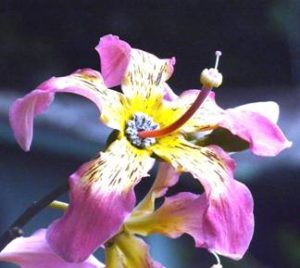
Hibicus-like flower of the Brazil kapok, Botanic Garden. Photo: Ryan Truscott
The tree is native to South America, but is cultivated throughout the tropics. The Flora of India website describes it as one of the most beautiful trees in the world.
It was thought that this tree, Ceiba speciosa, belonged to the Bombacaceae family, the same as our Baobab tree, Adansonia digitata. After all they do share some similarities: the bulbous trunk; the digitate leaves; the ability to withstand arid conditions; the striking flowers. But the tree that calls parts of Argentina, Bolivia, Brazil and Paraguay home has been moved to a different family: Malvaceae, the same as our Snot apple, Azanza garckeana.
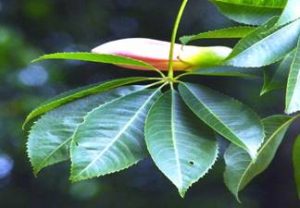
Digitate leaves of the Brazil Kapok, Botanic Garden. Photo: Ryan Truscott.
One amazing feature of the Brazil kapok is the well-armed trunk, which is heavily-studded with cone-shaped thorns.
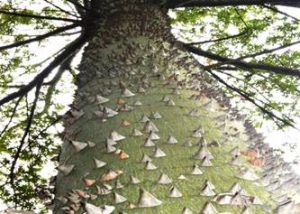
Well-armed trunk of Brazil kapok growing along Downie Avenue . Photo: Ryan Truscott
Another is the pods, which crack open to reveal silk cotton-like fluff. This silk has commercial value as stuffing and is used as a useful and eco-friendly substitute to synthetic materials. It also gives the tree one if its other common names, the Silk floss tree.
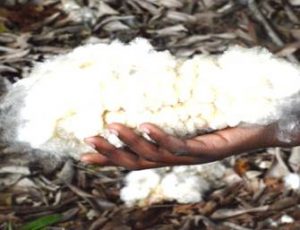
Silk from pod of the Kapok tree, Ceiba pentandra, Botanic Garden. Photo: Ryan Truscott
It’s also similar to the silk produced by the tree’s more famous cousin, the Kapok tree, Ceiba pentandra — that iconic, dominant species of the Amazon rain forest that you hear about in nature documentaries.
Late this month I took a visit to Harare’s National Botanic Garden to see both species growing there. The Brazil kapok growing behind the herbarium was covered thickly with flowers and buds, promising a spectacle that may last into April.
-Ryan Truscott
National Botanic Garden tree walk on Saturday 2nd March 2019
The sky was clear, it was a bit cool at first, but it did get pretty warm later on. Present were our gurus – Mark and Meg. Also present were Ann & Jim Sinclair, Ryan, Dawn, Sarah & Richard, Tony, Jan and a new face – Katharina who has since joined the Tree Society. Jan led the morning’s outing and we looked at trees in the Medium Altitude Rain forest.
No one appeared to know what the range of altitude was for this rain forest although somewhere in the Acacia Handbook Middleveld is described as being between 750 and 1200 metres above sea level. Within this forest we found a Strychnos potatorum which I had earmarked for a label but had forgotten its whereabouts!
-Tony Alegria
Five standout trees in a medium altitude RAIN forest (and how to recognise them)
In early March we explored a section of the Botanic Garden that has trees found in medium altitude evergreen forests: the kind you would encounter in Mutare, the Vumba, Honde Valley and other spots in the Eastern Highlands. Here are five standout trees, and tips on how to identify them.
African coca tree
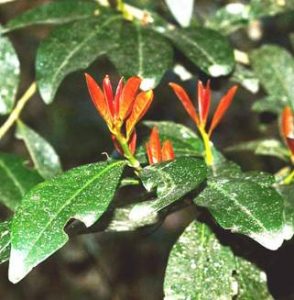
African Coca tree, Erythroxylum emarginatum Botanic Garden, Photo: Ryan Truscott
This tree was in fruit at the time of our visit. But when it’s not, another key feature of Erythroxylum emarginatum is the bright red leaves that grow at the tips of the branches. I’ve seen this species growing as an understorey tree in the Vumba and in the forested seaward facing slopes of Mutare’s Cecil Kop Nature Reserve. The red leaves stand out like miniature candle flames in the shadowy gloom. But Tony Algeria showed us another trick: crush one of the green leaves between your fingers and listen to them crackle as if they were dry and brittle. Another tip is to look for a little notch at the apex of each leaf.
Fern-leaf
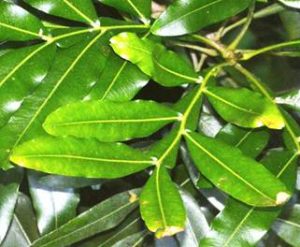
Fern Leaf, Filicium decipiens means “deceptively fern-like”. Botanic Gardens. Photo: Ryan Truscott
If you see a tree with glossy fern-like leaves, you know you’ve stumbled on the Fern-leaf. Appropriately its scientific name Filicium decipiens means “deceptively fern-like”. The flowers are inconspicuous so the distinctive leaves are a useful tool to identifying it in the field though care should be taken not to confuse it with the Winged bersama, Bersama abyssinica. I found seedlings of both trees growing next to each other along the Banga River (alt. 840 metres) in the Burma Valley last November. I mentioned this and it prompted discussion on what constitutes “medium altitude”. Tony Alegria suggested it covers anything between 750-1,200 metres.
River-thorn pear
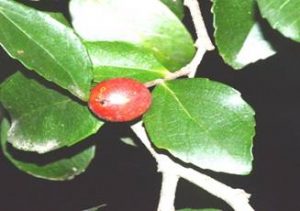
River Thorn Pear, Scolopia stolzii Botanic Gardens,. Photo: Ryan Truscott
This tree had us stumped on a Botanic Gardens visit last November to brush up on species likely to be found in the Vumba ahead of a society trip there. Fast forward to March and we find it in fruit and are able to identify it as the River thorn-pear, Scolopia stolzii. The fleshy red fruit are a distinctive feature but, in the absence of those, so are the dentate leaves. The Flora of Zimbabwe website says that this tree is listed as “near threatened” by the International Union for Conservation of Nature.
Common coral-tree
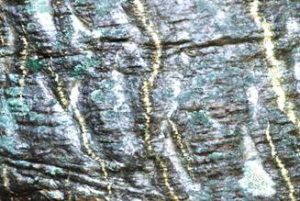
Erythrina lysistemon, note stretch marks on bark. Botanic Gardens. Photo: Ryan Truscott.
Okay, so this tree was growing amongst the evergreens in the garden. It’s unlikely to do that in the wild but it is certainly a Vumba tree and grows at the Bunga Views, an area of grassland and msasa woodland at the edge of the Bunga forest. The specimen in the garden had none of the characteristic red flowers and seeds. But the heart-shaped leaves growing in threes are a field characteristic. When it loses its leaves the bark on the tree trunk is a last resort to aid identification: distinctive stretch marks running up the trunk single it out as Erythrina lysistemon.
Hairy cola
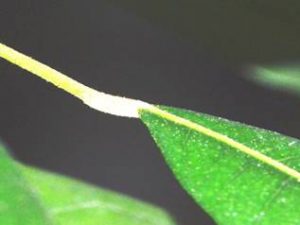
Hairy cola tree, Cola greenwayi (note pulvinus at base of leaf) Botanic Garden. Photo: Ryan Truscott
This is an understorey tree and, with its dark leathery leaves, could easily be overlooked if not in flower or fruit. But fear not for there is a sure way of telling Cola greenwayi apart from the mass of other greenery. Pick a leaf. Notice the long leaf stem? And there, right at the point at which it joins the base of the leaf is a swelling. There’s even a botanical term for that: a pulvinus.
-Ryan Truscott
Tree outing to Bridgeways 23 march 2019.
Once again we were invited by the Sinclairs to their property at Bridgeways in Avondale.
This estate of cluster homes is a green oasis in the centre of Harare. Many trees were planted here, making it a beautiful retreat, shady and full of color. Having visited this place before and feeling at home with the Sinclairs we had all sat down, talking and updating each other, when Meg reminded us that we were here to see some trees. With Jim and Ann directing us and Tony and Meg to help us identifying the many indigenous and foreign trees, we started our stroll.
Passing a young Schotia brachypetala, Weeping boerbean, growing under a huge Faidherbia albida, Another tree, we came to was a Syzygium that had never flowered and was still an enigma for Ann. This could be the introduced Syzygium jambos, Rose apple, which has been planted copiously in the country. Confirmation of this is difficult without seeing flowers or fruits. 7 species of foreign Syzygiums have been introduced in southern Africa.
Still in proximity of the house a sizeable Bridelia micrantha, Mitzeerie, and a Podocarpus with small leaves. This could be Podocarpus falcatus, or P. madagascariensis which has also been planted in Harare, considering the size of the leaves which were maximum 3 cm long, where for falcatus it should be between 3 and 5 cm according to the books. And not much of a sickle shape could be imagined in its leaves.
We stopped at a Dovyalis caffra, Kei-apple, and Meg asked us to look at the mid-vein which doesn’t reach the apex. This is a feature that helps differentiating it from Dovyalis zeyheri, oval Kei-apple which has slightly bigger leaves that are usually hairy. We were able to compare the 2 when a few meters further we saw this species and observed that this one did not have the cushions with clusters of leaves which is another diagnostic of the caffra species. It was mentioned that the Kei-apple with its sharp vicious spines has been planted as an impenetrable hedge in many places.
In between a hedge an attractive red flower was named Ruspolia seticalyx, a native shrub. Many foreign trees were planted here. We passed Thevetia peruviana, Yellow oleander, an attractive but very poisonous tree with lanceolate leaves and Tipuana tipu with its compound leaves and also flowering yellow. Two trees that have been planted all over Harare, introduced from Central and South America.
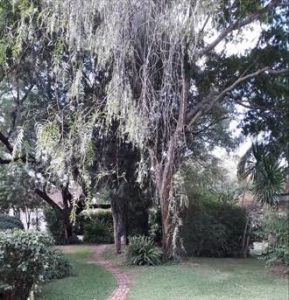
Schinus molle Photo: Jan van Bel
Walking in the shade of a huge Albizia gummifera, smooth-bark flat-crown, we were attracted by a willowy shaped tree with plenty of pepper corn seeds which Ann identified as Schinus molle, Pepper tree. The other tree from the same genus: Schinus terebinthifolius could be seen a little further.
A huge Acacia warranted another stop. Its pods were indicative of Acacia (Vachellia) nilotica, scented thorn, but were not quite right so Tony observed. But confusion arose when examining the leaves. The leaflets were not close together as the books prescribe. So could still be another foreign Acacia. Another huge Acacia with white globular flowers could also not be identified (see picture below).
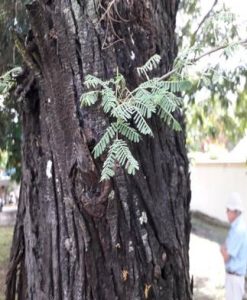
“Mystery” Acacia. Photo: Jan van Bel
One of the roads in the compound was bordered with several Pachira insignis, False chestnut, an exotic tree from the Kapok or Ceiba group. It has attractive red flowers and a big fruit capsule with nuts that can be roasted for eating. Another foreign tree Acrocarpus fraxinifolius, Kenya coffee shade tree, could not be missing here, as it is spreading all over Harare. Its very large extended compound leaves was remarked upon. Euphorbia tirucalli, Rubber hedge euphorbia was also bordering the road. We saw Cotoneaster in flower and Citharexylum spinosum, Lady Chancellor tree, was also not missing in this garden as it seems to be a prescribed tree for most Harare gardens. Karomia, Chinese hats, had red flowers, so was not our native K. tettensis but probably K. sanguinea, from the Himalayas.
Pseudolachnostylis maprouneifolia, Duiker berry; Tabernaemontana elegans, Toadtree; Diospyros whyteana, Bladdernut, with its shiny dark green leaves. Oncoba spinosa, Fried egg flower, had small, thin spines. A young Fernandoa let us examine its leaves. Then Tony spotted a Koelreuteria paniculata, China tree, with the huge compound leaves. Planted in gardens for its abundant yellow flowers and as a street tree. A young Combretum imberbe, Leadwood, had those characteristic grey-blue-green leaves. The two Burning bush or Flame Combretums were also present. Combretum microphyllum , the riverine type, and Combretum paniculatum, the forest liane, were standing in the same row along the river. Some Bauhinia galpinii, Red bauhinia were showing their attractive red flowers.
We had made the loop and were now back at the house next to a Berchemia discolor, Bird plum, where we also spotted Freylinia tropica, Nyanga hedge plant, with its blue flowers. Tea and coffee and scones and brownies were awaiting us. A special day it had been with lots of beautiful and educational tree species in a therapeutic relaxing environment perfectly organized by Ann and Jim Sinclair. Thank you so much.
-Jan Van Bel
TONY ALEGRIA CHAIRMAN
»»»
CONTACT TELEPHONE NUMBERS
Tony Alegria Home 2490375
Cell 0772-438697
Bill Clarke Cell 0772-252720
Isla Grundy Home 2882016
Teig Howson Home 2862066
Mary Lovemore Home 2490832
Cell 0772-261621
Ryan Truscott Cell 0772-354144
Ann Sinclair Cell 0772-433125
Jim Sinclair Cell 0772-233424
Jan van Bel Cell 0772-440287
You can contact the Tree Society via the new website: https://treesociety.org.zw/
Facebook: https://www.facebook.com/groups/336913913041780/
Annual Subs are $10 per family per year (due in April) and can be deposited in the Society’s CABS account – Acc. No: 1002549477. Acc. name: W.R.Clarke – Tree Society



